Federico Federici is a visual artist, writer, translator, and physicist. He works primarily in asemic texts: here, a mixture of typeset, splashes of color, and calligraphic obscurities, lying somewhere between auto-writing and a quest for pure expression. Art Editor Morgan Fox talks with Federici on his process, the nature of asemic texts, and the philosophy of inter-modal art.
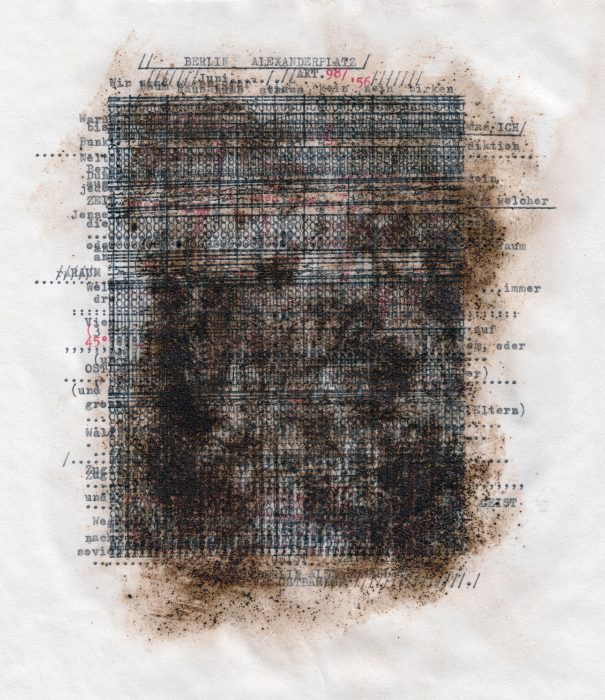
AKT: 98-56 (Olivetti Studio 46, ink, powder, glue, digital on paper, 297×210 mm approx., 2018)
Morgan Fox: Would you mind starting by describing asemic writing and asemic art, for people who might not be familiar with the term?
Federico Federici: At a loose glance, asemic writing might be interpreted as some real writing expressed by means of corrupted calligraphic gestures. Were it barely so, any sequence of scribbles, no matter whether intended or unintended one, would effectively work as an asemic text. I would instead draw attention on the fact that while any corrupted text originally existed somewhere as a readable one, as a fixed reality, if only in the mind of the writer, asemic writings tend to be unreadable from the very beginning. There’s a tacit method in that unreadability though, and that is what interests me most.
Resourceful writers and readers share the same expectation in the same experience of finding themselves before a wall of interfering gestures they look at and which looks at them. It’s like standing before a clouded pane: if you light it up too much from your side, you can’t see anything through it. But if you let light travel from the other side, a whole world outlines itself. Who put all those things there? Who casts that light behind the pane? Neither the writer did, nor ultimately does the reader.
On the other hand, asemic writing may even be the door you have lost the key of, a sort of closed eye vision. Texts neatly written in lost languages work as unauthored powerful asemic machines, though they were not conceived of as such. Despite their structures have gone astray and the original meaning is beyond reach by now, they continue exhibiting some bent for meaning, as strings feebly vibrating at every glance, playing their unending music.
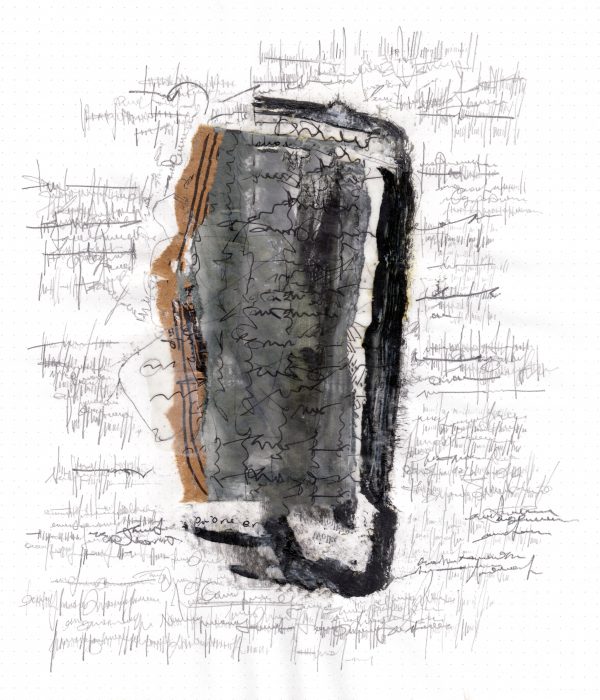
Am herz des Gedichtes (Ink, pencil, plastic, glue, digital on paper, 297×210 mm approx., 2018)
MF: What, then, goes into the process of composing an asemic text?
FF: From a personal perspective, inspiration often comes as a sudden need of escaping the wall (or veil) of my conventional words – «die Grenzen meiner Welt […], der Sprache, die allein ich verstehe» as Wittgenstein put it. To attain this by a purely asemic practice, I often start to draft pages, copying random sentences, recording vague thoughts in a colloquial language, not caring so much about the meaning, but concentrating on the rhythm of my hand. I’m like a runner training in the suburbs, constantly checking his heartbeat while not paying attention to the landscape at all. Then my handwriting gradually starts flickering, blurring smooth communication, till a certain weakening of the instant understanding is achieved. This usually involves techniques of overwriting, striking through and so forth which primarily intertwine the text as a texture.
Since the friction of nibs or pen tips on different papers and the fluidity of inks as well are all factors that may impact calligraphic gestures, I like testing different combinations, though I tend to prefer those in which a certain unevenness is involved. I sometimes feel like a deaf composer, finally hitting unlabelled piano keys, plucking loose strings after a tune which is in my mind, which I ‘dance’ to the rhythm of. That is why I often use musical notations to entitle these works.
In other cases, I choose concrete structures wherein to let asemic interferences come into play.
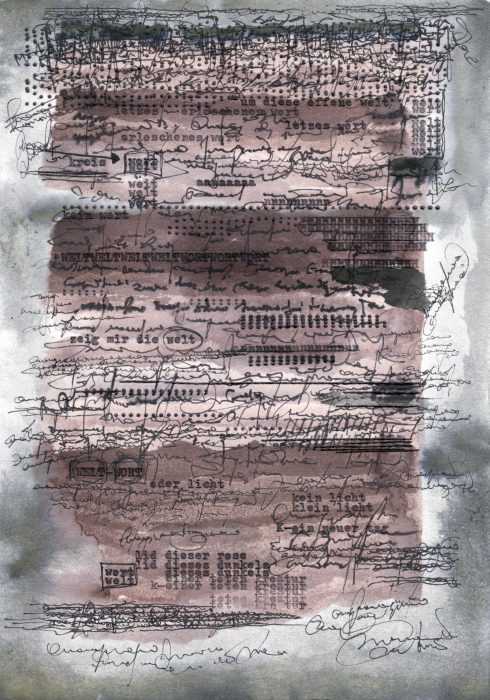
Das Gleichgewicht der Welt (Olivetti Studio 46, ink, gouache , digital on paper, 297×210 mm approx., 2019)
MF: The title of the series, “asemic/concrete tables,” offers a paradox, if we consider “asemic” as abstract and “concrete” as tangible. What role does the concrete play in these pieces?
FF: This series is part of a broader and still open project, Studies on asemic interferences on and within concrete structures, which establishes a dialectic between free asemic germination and mostly typewriter-generated concretism. This latter consists of frames, massive bulk of syllables, letters and figures, within or without which calligraphic gestures get excited and act/interact as vibrations, as waves diffracting through the interstices of residual patches. Concrete frames may contribute sparse microtextual references. Short sentences or isolated words are punctuated by longer blanks in which meaning is suspended. The familiar environment of the page gets disrupted and the conventional codes or strategies of interpretation are deactivated. Asemic strings hit the surface of textual blocks, make their atoms/alphabets vibrate till the breakdown of that unity.
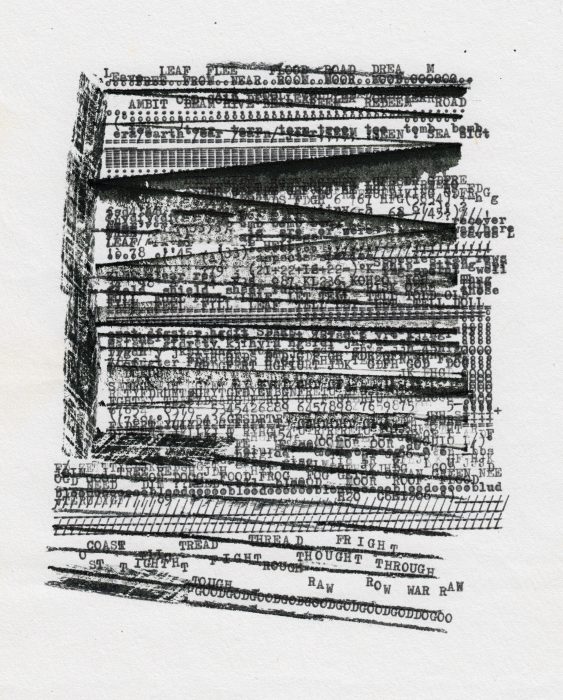
Thought grinding machine (Olivetti Studio 46, ink, digital on paper, 297×210 mm approx., 2018)
MF: I see that you’re also a translator. Being multilingual myself (with French and Russian as my primary foreign languages), I find that there’s sometimes a cognitive dissonance that occurs when I’m switching between languages, often resulting in words or phrases from a different language dropped in the middle of a sentence, and which can become even more confused when I switch between alphabets, especially while handwriting. Does language, for you, play a role in the creation of an asemic text?
FF: Writing in different languages, or even building a whole text letting different languages simultaneously aggregate and interfere with one another demands a continual readjustment of the focus. Over the course of the years, I have tried to take this to the extreme, from Requiem auf einer Stele, wherein I basically used English and German, to EIS which combines German, English and fragments in other languages with a strong concrete/asemic approach.
Every language adds a twist to the vision and casts a different light on the world with some inextricable degree of uncertainty. Human languages are not primarily sets of data, but sets of relationships. Were it not so, the whole world, say in the language A, would be experienced in the same way in the language B, provided that a certain shift is accounted for.
That does not actually apply to asemic texts, wherein expectations are suspended and the reader is requested the same entanglement as the writer. Asemic writing is a somewhat opaque interface that triggers the experience of a meaning whose integrity is preserved while not being overtly revealed.
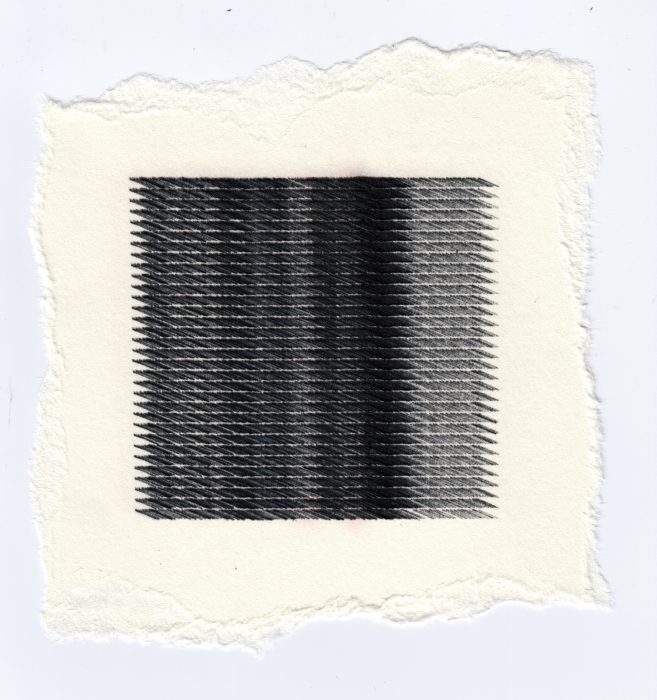
Die Kristalline Ordnung (Olivetti Studio 46, digital on paper, 120×120 mm approx., 2019)
MF: In addition to being a visual artist and a translator, you’re also a physicist. Do you find that physics influences your art, and in what way? (Similarly, does your art influence your physics?)
FF: There’s actually some sort of symbiotic relationship between the two. Nature falling under our senses is so pervasive and persuasive, like all known languages are, that we tend to forget that the whole business of the Universe should puzzle us on every second. Quite the opposite, we take most phenomena for granted. Sadly, the great play before us gets no more surprising than the background noise of people chatting at the bus stop.
Being born should instead be experienced as a unique, irreversible dive into consciousness. We are more than a rough collection of atoms and molecules drawn together by interactions. There’s such a degree of complexity, that we might start conceiving us as living texts, drawn from sparse syllables and words. Concrete/asemic writing may thus be addressed as an extreme attempt of experimenting with the play of meaningfulness, aggregating strings of potential writing. The enigma of looking at a text recalls that of standing before Kubrick’s ancestral or extraterrestrial monoliths.
I often turn to Physics to get unprecedented conceptual frameworks to interpret and drive what I am doing. The quantum world cannot be translated in terms of the classical world language, likewise asemic writing works around conventional languages. Certain ‘metaphors,’ such as particles, waves and so forth, turn out to be helpful at establishing some connection between the old vision and the new one, though. Yet, there’s a broader field which classical physics cannot draw from. Asemic writing may be concerned with the exploration of what is not accessible for direct textual perception along similar lines.
MF: A couple of these pieces suggest musical themes, such as the Chamber Music pieces, while others almost look like sheet music. I’m thinking specifically of “(First) attempt of rhyming silence,” which suggests to me an attempt at transcribing silence, and also could just be me projecting meaning onto the piece. Does music play a part in your process? Or, have you ever considered trying to musicalise asemic texts?
FF: (First) attempt of rhyming silence is indeed a braille alphabet of silence, or maybe the tracing of a cylinder unmounted from a carillon prepared by John Cage in the attempt to record silence on a tape. But asemic pieces are way more complicated than it looks. They are clearings where the leaves of grass intertwine and sing. Why should texts get muted when words disappear?
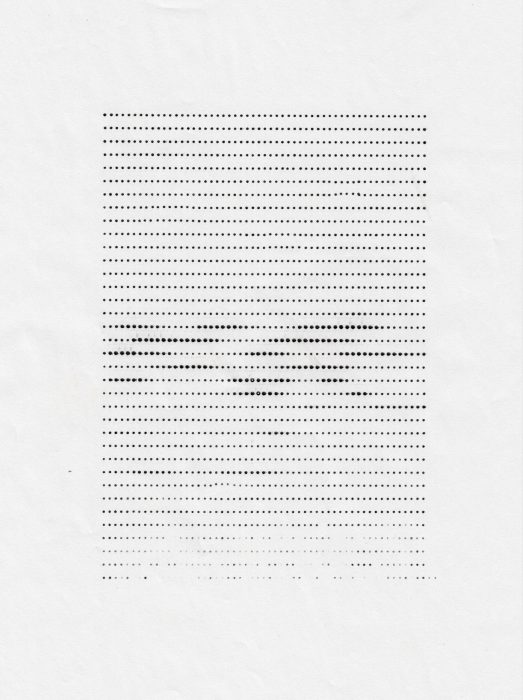
(First) attempt of rhyming silence (Olivetti Studio 46, digital on paper, 297×210 mm approx., 2019)
When I think of what asemic reading would sound like, I can’t but refer to noise music, to the extreme experiments by Jakob Ullmann, or the textual landscapes by Torsten Kulicks. One must obviously surpass and drop any generally recognized phonetic rule and move towards something totally different from bundling loose segments and make them sound.
The sensory and conceptual experience of looking at an asemic page suggested to me that a sound rendering could be achieved by means of a scanning machine. To this end, a couple of years ago, I set up a virtual video installation, imagining to perform an in vivo text scanning with the help of a device which I named Asemic Force Microscope (AFM), after the Atomic Force Microscope which is properly a type of scanning probe microscope.
MF: The piece “RaumZeit,” for me, recalls the line from Wagner’s Parsifal, “zum Raum wird hier die Zeit” (“And here Time turns into Space”). Like Parsifal on his quest in the ambiguous realm of space-time, can (or do) asemic texts, with their emphasis on deconstructing meaning, push us towards an understanding of truth (in meaninglessness)?
FF: That piece is purely vispo and concrete. I conceived it as a straightforward representation of both the pre-relativistic and the relativistic concepts of space and time. On a Sunday afternoon, I was sitting at the table in my studio, playing with some sheets. All at once, while I was holding one about the size of my hand, I started thinking of hands as a perfect synthesis of both time and space: fingers pulse and span some amount of space when spread out. Were there enough hands, the whole Universe could be spanned and there would be the beating of some heart everywhere! How incredible! I then started to type a thick pattern of K’s, a letter that originally comes from the semitic symbol for an open hand, as if to cover the whole page. After some lines, I put a break in the loop, to cover a small amount of paper with space only (RAUM, 4 lines), but leaving a certain gap between the letters, as if something was missing. Again, I started over with the same thick pattern of K’s, before putting another break, to cover another small amount of paper with time only (ZEIT, 4 lines). This was somehow the situation before Einstein. I started over with another set of K’s, then I stopped and fused RAUM and ZEIT into a single concept: no more gaps, but a continuum in which both words are simultaneously preserved and merged into a neologism (RZAEUIMT, 4+4 lines).
This work actually addresses that process of relentless construction and deconstruction of meaning you hint at from a different perspective: no longer do asemic texts suggest the presence of words, but words themselves, old and new ones, properly layered, serve to build the vision of (and point to) something transcending their literalness.
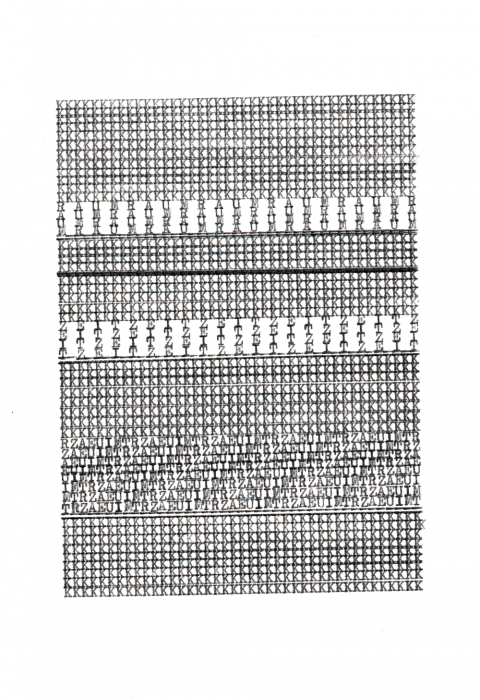
RaumZeit (Olivetti Studio 46, digital on paper, 297×210 mm approx., 2018)
Federico Federici is a physicist, a translator and a writer. He lives and works between Berlin and the Ligurian Apennines. His texts have appeared in 3:AM Magazine, Jahrbuch Der Lyrik 2019, Poet Lore, Sand, Trafika Europe, Magma, and others. Among his books: L’opera racchiusa (2009, Lorenzo Montano Prize); Appunti dal passo del lupo (2013), in the book series curated by Eugenio De Signoribus; Mrogn (2017, Elio Pagliarani Prize); Requiem auf einer Stele (2017); Liner notes for a Pithecanthropus Erectus sketchbook (2018), with a foreword by SJ Fowler; the poetry/concrete catalogue, A private notebook of winds (2019). In 2017 he was awarded the Lorenzo Montano Prize for prose. In 2019 he was awarded the Nassau Review Writer Awards for poetry.
LINKS
Website: federicofederici.net
Blog: leserpent.wordpress.com
